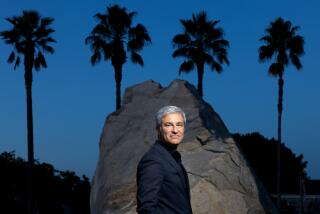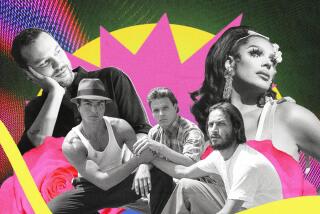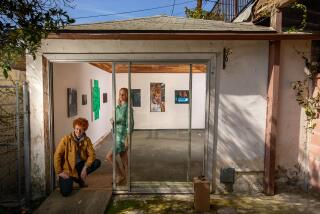Decaffeinating Poetry : A series of readings at the Los Angeles County Museum of Art is helping to drag the spoken word out of gloomy coffeehouses and into the erudite digs of the rest of the fine arts. It’s ‘word jazz’ without the java.
- Share via
It’s hard to say what painter Ernst Ludwig Kirchner might have said had he glimpsed it. If he were a man of good humor, he surely would have been a bit bemused.
Standing before his canvas “Two Women,” which elegantly details two stately women in broad black chapeaus, cowgirl poets Gail (Calamity) Wronsky and Molly (Belle) Bendall--in suede boots, denim and vests, all topped off, of course, with broad-brimmed hats--put the finishing touches on their own evocative tableau.
In a soft lilt, rounding out her love song, Calamity intones:
“ And so the two of us dove over the edge of that precipice, so to speak, into the diamond-studded, deep black velvet waves of the crazy quilt which is a cowgirl’s nighttime sky. “
There is a pause. Then cascading applause.
A woman pushing a baby stroller peeks around the corner into the gallery at the Los Angeles County Museum of Art. A touch bewildered, she takes in the source of this lively explosion of words that rise from a space usually as cool and as quiet as a tomb.
The Friday evening series, Writers in Focus, certainly isn’t writer-poet Meri Nana-Ama Danquah’s blushing first attempt to assemble hidden local talent and place them center stage. The series, which was launched in February with David L. Ulin and Russell Leong, has featured Wronsky and Bendall along with locals Kene Holliday and Joel Lipman.
Series curator Danquah, 26, is also associate director at Theater L.A. and has lent her name and organizing efforts to many a workshop, benefit and reading series. The jewel is the popular Thursday night series at Rosalind African Restaurant.
Asked last summer to participate in a special event in conjunction with African American artist Jacob Lawrence’s exhibit at LACMA, Danquah says she was struck by her own juxtaposition--reading her words amid precious works of art:
“It was real incredible to me . . . I never had a reading like that before in my life. You walk into LACMA and you’ve got this audience who is thirsty for art. . . . They are not the people who would come hear you read at Joe Blow’s coffee shop. They are not the people who would come hear you at Whittier College . . . but they are people who go to LACMA and subscribe because they are people who love art. . . . It’s a wonderful thing for LACMA to embrace the spoken word as an art.”
Danquah is not simply an advocate for the spoken word. She has emerged as a doting surrogate parent of sorts to L.A.’s booming literary scene. And as any concerned parent would, she has observed that for writers interested in presenting their work to a varied audience, there isn’t always a natural progression, one commensurate with the trajectory of their careers.
Beyond Baroque, the Venice literary center, has provided a highly visible and comparatively accessible stage, she concedes. But reading series hosted by the Lannan Foundation and Chateau Marmont are limited to those writers who have been knighted with “star status,” Danquah maintains. And while coffeehouses are moody workshop settings for the spoken word, Danquah wants to continually up the ante.
“When you go to coffee shops, you have people who just sort of stumble in just because they want a cup of coffee or a cappuccino. It’s very pedestrian, it’s a starting level,” she says.
With the LACMA series, Danquah hopes to rescue some of the city’s more tenured poets and writers from nightly competition with the whir of the coffee grinder, the roar of a Pasquini machine steaming milk.
*
Somehow, somewhere, the two became synonymous, or, at the very least, irrecoverably tied: java and word jazz. When literary salons moved out of Verdi-filled parlors in the ‘50s, they set up shop in the noisy basements of bookstores or coffeehouses scattered liberally around such bohemian enclaves as Greenwich Village and San Francisco’s North Beach.
Although a small, underground scene existed on the fringes of the beat movement--in what was then called “Venice West”--it wasn’t until a few decades later that thirsty L.A. fully drank in coffeehouse culture and all that accompanied it.
The ‘90s have exploded with espresso bars furbished to look like everything from someone’s living room to a drafty monastery chapel filled with hard-on-the-tailbone pews, and offering everything from open-mike nights to poetry slams. The city’s neo-beat literary scene, rejuvenated as much by the allure of rap as by the inevitable fond-glance-backward nostalgia, has provided behind-the-mike venues for poets.
But for many who have made the rounds for decade or two, a noisy coffeehouse gig is no longer looked upon as an opportunity, but rather an insult.
“This series helps writers who have been blocked,” says Harvey R. Kubernik, a local recording producer and audio poet. “You don’t have to be 48 years old with a book to be heard. Meri’s acknowledging a native voice . . . and creating an open-door policy for writers who have been feeling that academia has been taking cuts in line.”
With LACMA, Danquah plans to create something on the scale of the St. Marks Poetry Project or the 92nd Street Y--New York institutions whose names carry formidable weight in literary circles nationwide.
“It means that they have some amount of established reputation . . . that you’ve sort of been sanctioned by this institution,” she says. In L.A., “There is no middle ground.” So Danquah pursued Lisa Vihos, LACMA’s associate museum educator, after the Lawrence series. “I thought that it was the responsibility of the museum as an arts institution to foster talent in that area,” Danquah says.
Although still in its fledgling stage, and requiring skills worlds away from hanging canvases, LACMA is ready to press forward.
“We’re just really excited about providing a venue,” Vihos says. “It’s just another branch. We plan these evenings to take place on Friday night . . . an active time in the museum. We have jazz on the plaza and wanted to encourage people to come into the gallery. By having the reading . . . we get people who are enjoying the music to come inside, (while) the museum-goers are hearing poetry.”
Poet Sesshu Foster, who will read later this month with Michelle T. Clinton, points out that mixing media can work on many levels: “I hope that it would encourage more interchange and interaction between different arts and artists. The best thing that can come out of all of this would be some cross-fertilization of aesthetics and ideas. A kind of informal multicultural exchange within an established institution. I think the more that kind of movement becomes more fluid, the healthier it becomes, for everybody, in the long run.”
Wronsky, who teaches creative writing at Loyola Marymount University, believes that the emphasis on performance most characterizes poetry in L.A. She has noted a direct correlation between performances and increased enrollment in classes concentrating on constructing verse.
“Poetry is much more visible than it used to be. It’s not considered quite so effete anymore,” Wronsky says. “Students are not afraid to write really raunchy stuff. They’ve seen it in print. They know that they can write about their inner lives, talk about it in workshop, and they won’t be censored. It is serving some important function in their lives.”
*
The series’ most beguiling feature--the energy and diversity of the coffeehouse scene fused with the rarefied atmosphere of a high-art venue--may have a catch, Wronsky points out.
Language and content that might pass without pause at the Onyx or the Iguana Cafe may not wash with the museum set, as performance artist Elia Arce and poet-journalist Ruben Martinez found on a recent evening.
“There was a lot of graphic fusion between flesh and spirit,” recalls Martinez. “I did notice some people moving around . . . a lot of tension in the room. . . . (But LACMA) didn’t ask us about the nature of our material. If they are concerned for their audience, well then, what do they think poets write about? Maybe LACMA isn’t used to the art world I’m used to. . . . They can deal with Diebenkorn . . . but nothing that rests out of the classical mainstream. I’ve never censored myself for anybody. I don’t think art and censorship mix.”
Arce, too, replays the scene, but with a shade of bemused detachment: “It’s so funny you know, because usually I do that piece nude,” she says with a generous laugh. “But I thought . . . I’ll be conservative . . . I’ll put on a lace dress.”
There were other compromises as well. Her trademark props--a candelabrum and incense--went against museum rules. “I guess,” Arce admits, “I felt that I didn’t belong there. The minute I had to start making concessions that directly affected the presentation of my art . . . that immediately made me feel a separation between what is shown there as ‘real art’ and my work.”
Interestingly enough, Vihos says, although there was plenty of strong imagery and language--and about 10 people from a capacity crowd of about 100 left--”Nobody came up to me and said they were upset.”
Now, however, LACMA is taking precautions. An on-site placard that announces the readings warns: “Some of the language and topics may be objectionable to some visitors. Discretion is advised.”
At first, Danquah admits, that news annoyed her “because I really wanted to go like gangbusters. I mean isn’t that the issue, First Amendment? . . . I think what they expected was ‘nice poetry,’ which is what I’m giving them. It’s just a different definition of nice .”
But now she realizes that “you have to give a little to get a little. . . . It’s not going to kill me or my writers.”
Instead, she plans to concentrate on the rest of this season, which will include readings by Luis Alfaro, Michele M. Serros, Ralph Angel, David St. John, Clinton and Foster. The line-up for next season, once again focusing on L.A. writers, is just about set, but long-term funding is still in the works. And, says Danquah, who has provided her services gratis, “They’ve insisted on setting aside some funds with which to pay me.”
Still, she says the biggest boon is the nugget of insurance offered by linking up with an institution: “I wanted . . . an arts institution to take (the series) up because if I decide to step down as a curator it still exists . . . (and) someone else can come and make their contribution. I would like to establish a tradition, something that is ongoing. . . . We have to stop doing these one-shot deals. I want it to be something that is continuous.”
Like many local artists who have been lured by shimmering prospects only to find those streams quickly dry up, Arce echoes similar concerns.
“If this series happens again, and I’m invited again,” she says, “then we can sing victory. But in order for any change to occur, only commitment leads to true action. So I hope so . . . but let’s see.”
More to Read
The biggest entertainment stories
Get our big stories about Hollywood, film, television, music, arts, culture and more right in your inbox as soon as they publish.
You may occasionally receive promotional content from the Los Angeles Times.










